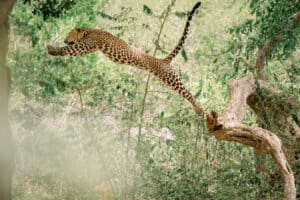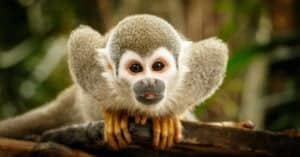Monkeys come in all shapes and sizes and exist around the world. Most monkeys live in Africa, Asia, Central America, and South America. While many hang from branches and leap from tree to tree, several monkey species are terrestrial as well. Some wild monkeys even spend their time in human-populated areas!
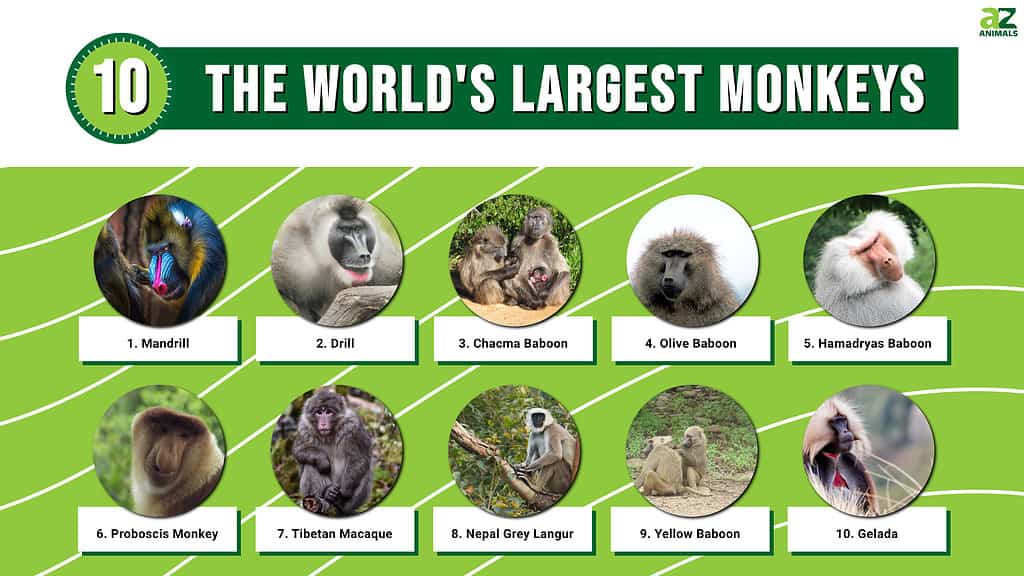
Monkeys are also great examples of sexual dimorphism. This is when males and females have distinct physical differences, typically in size and coloration. An example of sexual dimorphism is size and coat color of black howler monkeys. Males typically weigh around 32 pounds and have a black coat, whereas females typically weigh 16 pounds and have a blonde coat. It is very common in primates for males to be larger than females primarily due to mating competition. Monkeys are incredibly social animals that compete, communicate, and cooperate in many fascinating ways. Here you will learn about some of these incredible animals. These are the 10 largest monkeys in the world based on maximum weight.
#10 Gelada- 45 pounds
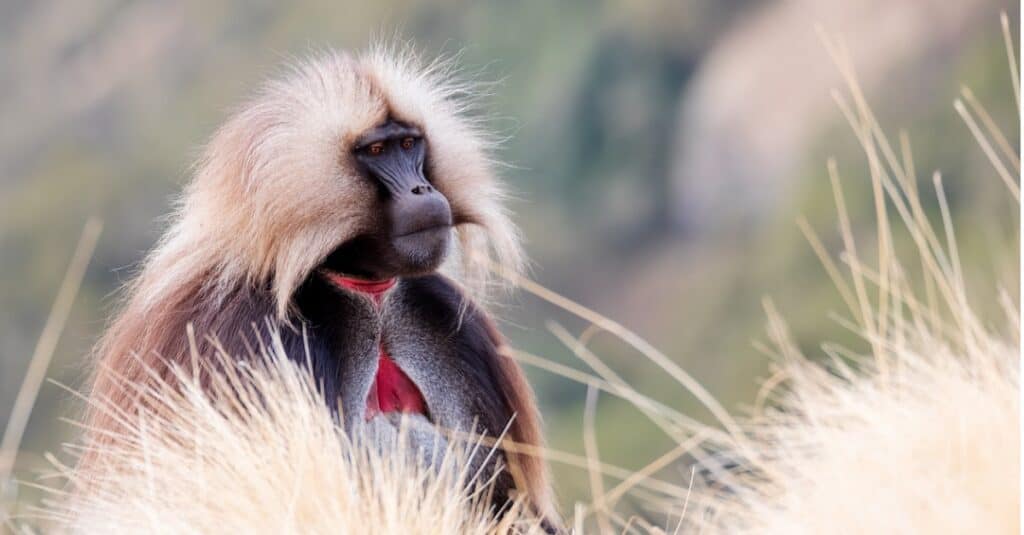
Gelada monkeys are often called “bleeding-heart” monkeys. They are among the largest monkeys in the world.
©Artush/Shutterstock.com
The gelada, sometimes called the bleeding-heart monkey, can weigh up to 45 pounds. This monkey is a terrestrial species that inhabits the grasslands of Ethiopia where its diet consists almost entirely of grass. Many people mistakenly think geladas are a type of baboon, but they actually belong to a different genus. Geladas currently have a conservation status of least concern and are only threatened by human-induced habitat destruction. Their predators include species like leopards and hyenas.
Geladas have an incredibly complicated multi-tiered social system as well as unique social behaviors. When a gelada is aggressed or enacts aggressive behavior, it will flip its upper lip over its nose to expose its large teeth. This posturing is common between competing males and can result in a physical confrontation. Males also prove their quality as a mate with the vibrant red patch on their chests. This red, hairless area becomes brighter in males as hormone levels rise, signaling when they are most fertile. Females also have this red patch, but it is less bright. Blisters will form on the female’s red chest when she is most receptive to mating.
#9 Yellow Baboon- 55 pounds
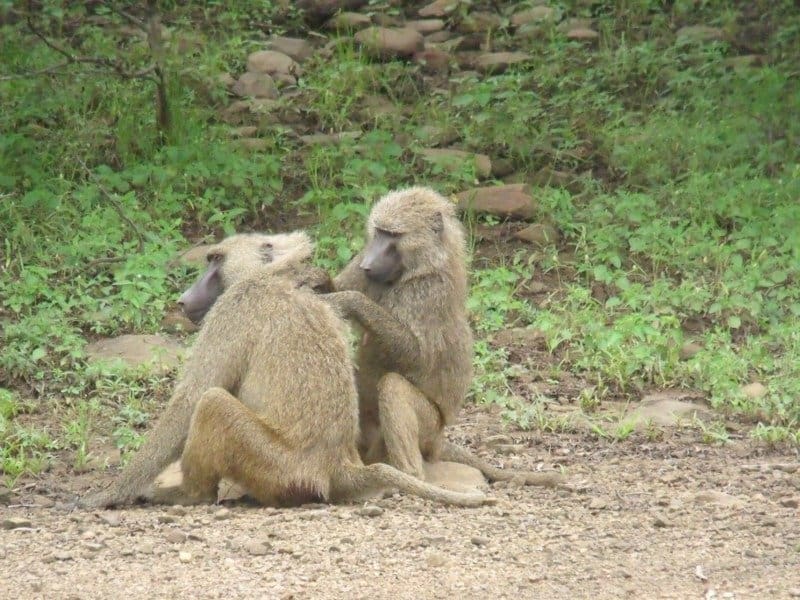
Two yellow baboons grooming each other
©Florence Bond – Copyright A-Z Animals
Yellow baboon males can weigh up to 55 pounds. The yellow baboon is named for its distinctive yellow hue and can be found in savannas in eastern Africa including Kenya, Tanzania, Zimbabwe, and Botswana. The conservation status of the yellow baboon is least concern.
Yellow baboons live in a social hierarchy where there is a dominant male and inferior males that must compete. Rank in the hierarchy greatly impacts the reproductive opportunities available to an individual so competition is fierce! Each troop can consist of 8 to 200 baboons and includes males and females. An interesting behavior documented in yellow baboons is lower-ranking males will approach higher-ranking males while holding an infant above their heads as a way of showing they do not intend to attack or fight.
#8 Nepal Grey Langur- 58 pounds

Nepal grey langurs can grow to 58 pounds
©iStock.com/Utopia_88
The largest Nepal grey langur ever recorded was 58 pounds, however, males are typically around 40 pounds. These langurs live in the Himalayan region in Nepal, Tibet, India, and Pakistan. They typically inhabit forests at 1,500 to 4,000 feet in altitude. These monkeys have a conservation status of least concern.
Nepal grey langurs are both arboreal and terrestrial which means they spend time on the ground and in trees. They frequently run on all fours and can even leap 15 feet! They are common in developed areas populated by humans and sometimes sleep on telephone poles instead of high up in a tree as normal. Nepal grey langurs are also known to bark, scream, and hiccup as forms of communication with others of the same species.
#7 Tibetan Macaque- 66 pounds
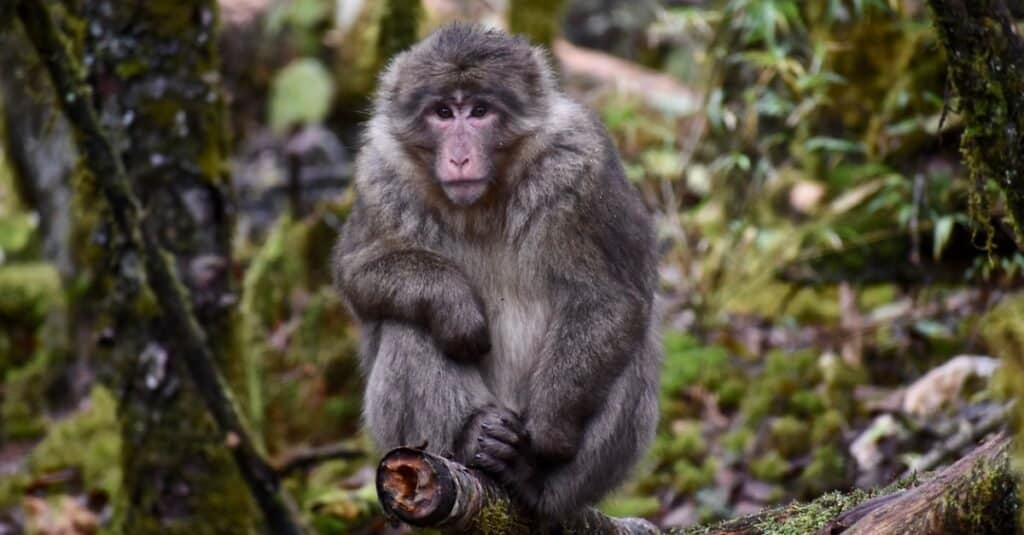
The largest Tibetan Macaques ever recorded weighed 66 pounds!
©PhotoZeli/Shutterstock.com
The largest Tibetan macaque ever recorded was 66 pounds despite their typical weight of 29 to 43 pounds. They are one of the largest monkeys in Asia and can be found in Tibet and north China. The conservation status of Tibetan macaques is near threatened which means they are at risk of becoming endangered in the future.
The Tibetan macaques also have very interesting behavior. Scientists have documented distinct communications that each serve a different purpose including a coo, squeal, squawk, loud scream, growl, bark, weep, modulated tonal scream, and pant. They also use different facial expressions to communicate and are considered to have a more diverse variety of communication than any other macaque. Competition between males is also particularly gruesome. Males are known to fight other males in the dominance hierarchy for access to better food resources and mates. These fights are very violent and often lethal.
#6 Proboscis Monkey- 66 pounds
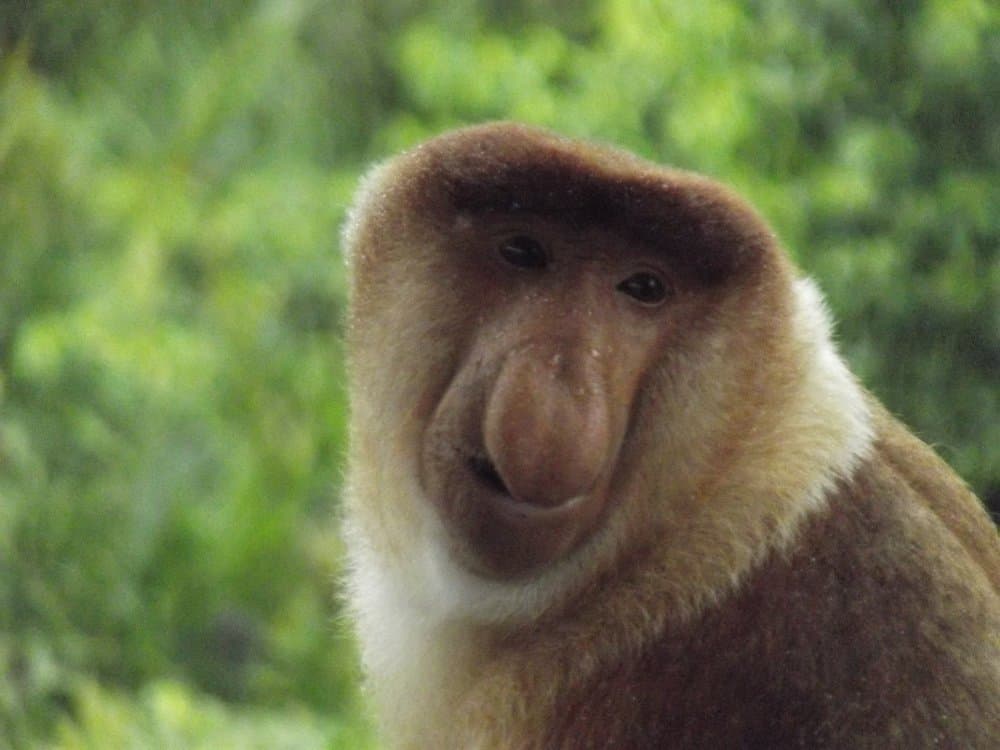
Male Proboscis Monkey, Labuk Bay near Sandakan
©Wendy Bird – Copyright A-Z Animals
The largest proboscis monkey on record is about 66 pounds, but males are most often between 35 and 50 pounds. Proboscis monkeys, appropriately nicknamed long-nosed monkeys, are only found in Borneo Malaysia, and Indonesia. These monkeys are classified as endangered largely due to habitat loss from logging, oil palm plantations, and hunting.
The proboscis monkey is well known because of its incredibly unique nose. It is theorized that females prefer males capable of producing louder vocalizations. The larger nose facilitates in emitting louder calls which may make males more attractive mates. This one-of-a-kind nose can exceed 4 inches in length and often hangs below the mouth. Female noses are also large relative to other monkeys, although not nearly as large as the males. The drastic difference in nose size between males and females is another example of sexual dimorphism.
#5 Hamadryas Baboon- 66 pounds

Hamadryas Baboon, Munich Zoo
©Thomas Netsch / Public domain, from Wikimedia Commons, the free media repository – License
Male hamadryas baboons typically weigh up to 66 pounds. Females, however, reach a maximum weight of 33 pounds. These baboons primarily live in Eritrea, Ethiopia, Djibouti, and Somalia. These terrestrial monkeys’ habitats consist of dry, arid savannas and rocky areas. Interestingly, hamadryas baboons appear frequently in ancient Egyptian art and were considered sacred; however, they are now extinct in Egypt. Their conservation status is least concern.
The hamadryas baboon is different from other baboons and macaques because of their unique social structure. Many monkeys, including other baboon species, have a matriarchal hierarchy- a ranking system amongst females. Hamadryas baboons, however, only have a patriarchal hierarchy. Males of this species frequently get into violent fights over the females they control and will attempt to steal females from other groups
#4 Olive Baboon- 82 pounds

Papio anubis (Olive Baboon)
©Stolz, Gary M, Public domain, via Wikimedia Commons – License
The male olive baboon can weigh an impressive 82 pounds! Olive baboons have the largest geographical range of the baboon species and inhabit 25 African countries. They typically live in savanna or forest-type ecosystems in large groups of up to 150 individuals. The conservation status of this baboon is least concern.
As the most widespread species of baboon, olive baboons are highly adaptable. Although they are most common in savannas, they are also known to inhabit temperate grasslands, riverine forests, rocky cliff regions, evergreen forests, and even tropical forests in Uganda. Olive baboons, therefore, inhabit many very different climatic regions. These areas range from having non-existent to abundant rainfall, mild 50-degree Fahrenheit temperatures to scorching 104-degree temperatures, and dense tree cover to intense direct sunlight.
#3 Chacma Baboon: 99 pounds

A chacma baboon male, female, and infant
©Harald Süpfle, CC BY-SA 2.5, via Wikimedia Commons – License
Chacma baboons can weigh up to a massive 99 pounds! Chacma baboons are the largest species of baboon and are the largest monkey in the world by length. An adult’s body length can be up to 45 inches and tail length up to 33 inches. This baboon is found in southern Africa including South Africa, Angola, Zambia, Botswana, Zimbabwe, and Mozambique. The chacma baboon has a conservation status of least concern.
Despite their incredible size, chacma baboons are popular prey. A common predator to the chacma baboon is the leopard. It has been studied and recorded that just over 20% of leopard kills are chacma baboons. African wild dogs also prey upon these baboons despite being smaller in size. A study in Mana Pools National Park in Zimbabwe revealed that chacma baboons comprised 44% of total African wild dog kills.
#2 Drill – 110 pounds

A drill monkey is closely related to mandrills and baboons
©Millie Bond – Copyright A-Z Animals
The drill monkey is the second largest monkey in the world weighing up to 110 pounds! Drills are regarded as one of Africa’s most endangered mammals with only 3,000 existing in the wild. They are found in small areas of rainforest in Nigeria, Cameroon, and Equatorial Guinea.
Drills are less commonly known compared to the closely related mandrill, but they have similarly interesting features. A male Drill’s buttocks are incredibly colorful including shades of lilacs, reds, blues, and purples. The intensity of this coloration signifies a male Drill’s social rank within the troop. A male’s genitals are also shades of red and lilac. Females, however, are less vibrantly colored and greatly differ from males in body size. While males can grow to 110 pounds, females typically weigh up to only 28 pounds! Females also lack the pink coloration on the chin and have a plain grey-brown coat.
#1 Mandrill- 119 pounds
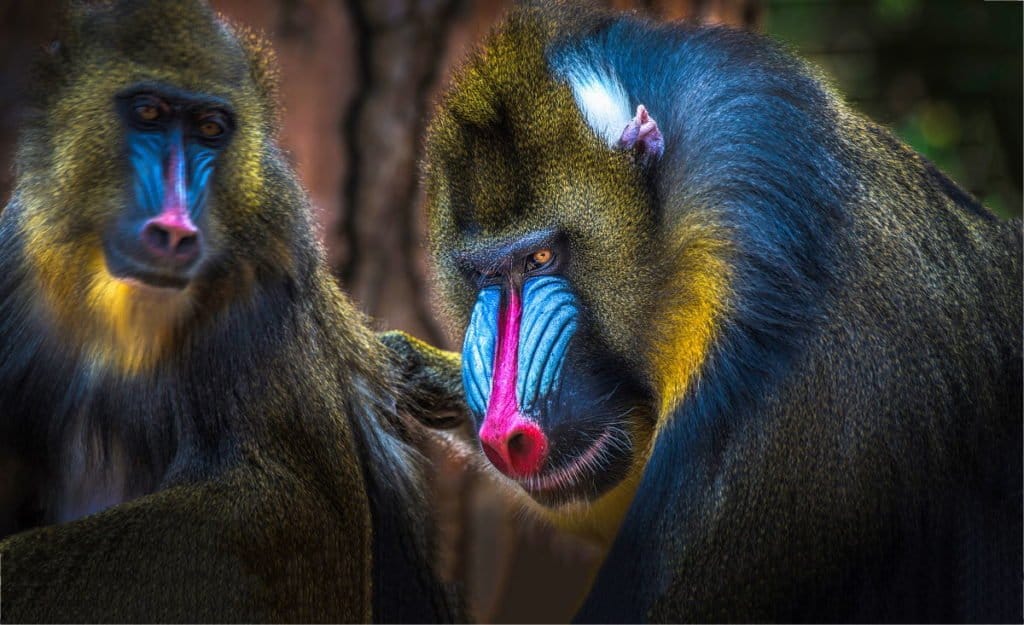
A male mandrill has distinctive face and body coloration
©Nikolay 007/Shutterstock.com
The world’s largest monkey is the mandrill which can weigh up to an incredible 119 pounds! The mandrill is easy to identify from its distinctly colorful face. In The Descent of Man, Charles Darwin wrote, “No other member in the whole class of mammals is colored in so extraordinary a manner as the adult male mandrill’s”. These beautiful and intimidating monkeys can be found in the tropical rainforests of Equatorial Guinea, southern Cameroon, Gabon, and Congo. The mandrill is currently listed as a vulnerable species.
A mandrill’s diet consists primarily of fruit and other plants. Less frequently, mandrills will eat meat in the form of small invertebrates such as beetles, termites, ants, and snails. They will sometimes eat small vertebrates including shrews, rats, frogs, and small birds. Mandrills only eat larger vertebrates opportunistically. Despite their amazing size, mandrills are not apex predators. Similar to chacma baboons, they are preyed upon primarily by leopards.
The mandrill is one of the most sexually dimorphic mammals in the world due to sexual selection and mating competition. While the male can weigh up to 119 pounds, the average adult female weighs 27 pounds. The male’s bright facial colors are also associated with sexual selection and do not appear in females.
Mandrills live in exceptionally large groups called “hordes”. A horde averages about 615 monkeys but can reach as many as 845. The largest horde on record- and the largest group of nonhuman primates ever recorded- was documented in Lopé National Park in Gabon and consisted of 1,300 individuals. Hordes typically consist of females and their dependent offspring. Males live solitarily and only join hordes when females are receptive to mating. Conflicts between males are infrequent, however, when they do occur, they can be deadly.
Summary Of The World’s 10 Largest Monkeys
| Rank | Monkey | Size | Found In |
|---|---|---|---|
| 10 | Gelada | 45 pounds | Ethiopia |
| 9 | Yellow Baboon | 55 pounds | Eastern Africa – Kenya, Tanzania, Zimbabwe, and Botswana |
| 8 | Nepal Grey Langur | 58 pounds | Himalayan Region of Nepal, India, and Pakistan |
| 7 | Tibetan Macaque | 66 pounds | Tibet and North China |
| 6 | Proboscis Monkey | 66 pounds | Borneo – Malaysia and Indonesia |
| 5 | Hamadryas Baboon | 66 pounds | Eritrea, Ethiopia, Djibouti, and Somalia |
| 4 | Olive Baboon | 82 pounds | 25 African Countries |
| 3 | Chacma Baboon | 99 pounds | South Africa, Angola, Zambia, Botswana, Zimbabwe, and Mozambique |
| 2 | Drill | 110 pounds | Nigeria, Cameroon, and Equatorial Guinea |
| 1 | Mandrill | 119 pounds | Equatorial Guinea, southern Cameroon, Gabon, and Congo |
Monkeys that are Large but Didn’t Make the List
There are over 300 species of monkeys divided into two groups, the Old World, of which there are over 170 species, and the New World, of which there are over 160 species. Of these species, there are quite a variety of large monkeys that deserve recognition. The Guinea baboon, and the mantled guereza, both of which belong to the Old World group, and the spider monkey, a New World member. Take a look at how they stack up:
- Guinea Baboon (Papio papio) – at a weight of 57 pounds, it is about the same size as the Olive Baboon. They are located on the far western tip of Africa and are listed as Near Threatened.
- Mantled guereza (Colobus guereza) – also known as the guereza and the eastern black-and-white colobus. This primate can reach up to 30 pounds.
- Black-headed spider monkey (Ateles fusciceps) – the largest of the spider monkeys, they can reach weights of over 30 pounds.
The photo featured at the top of this post is © Anton_Ivanov/Shutterstock.com
Thank you for reading! Have some feedback for us? Contact the AZ Animals editorial team.




